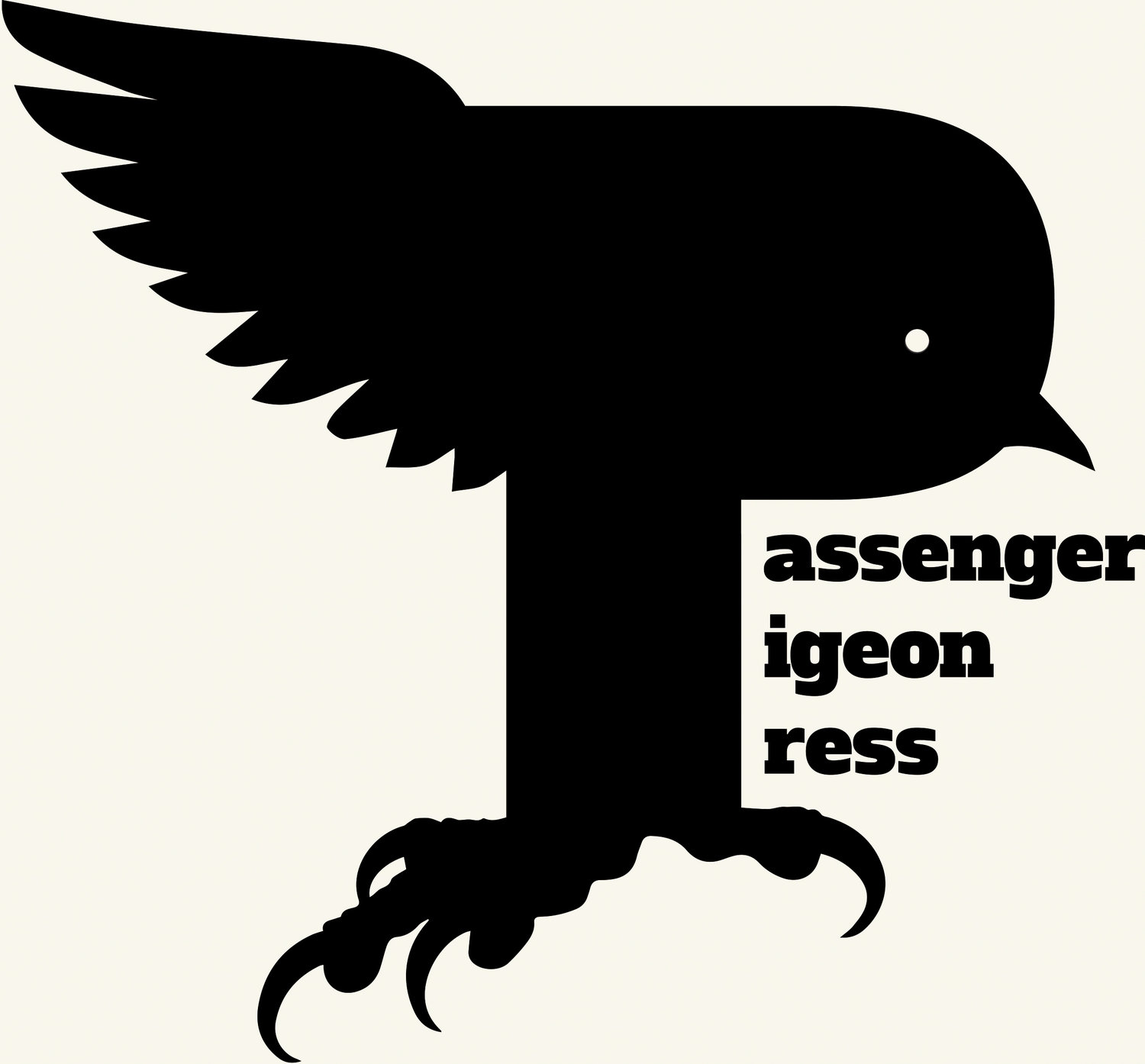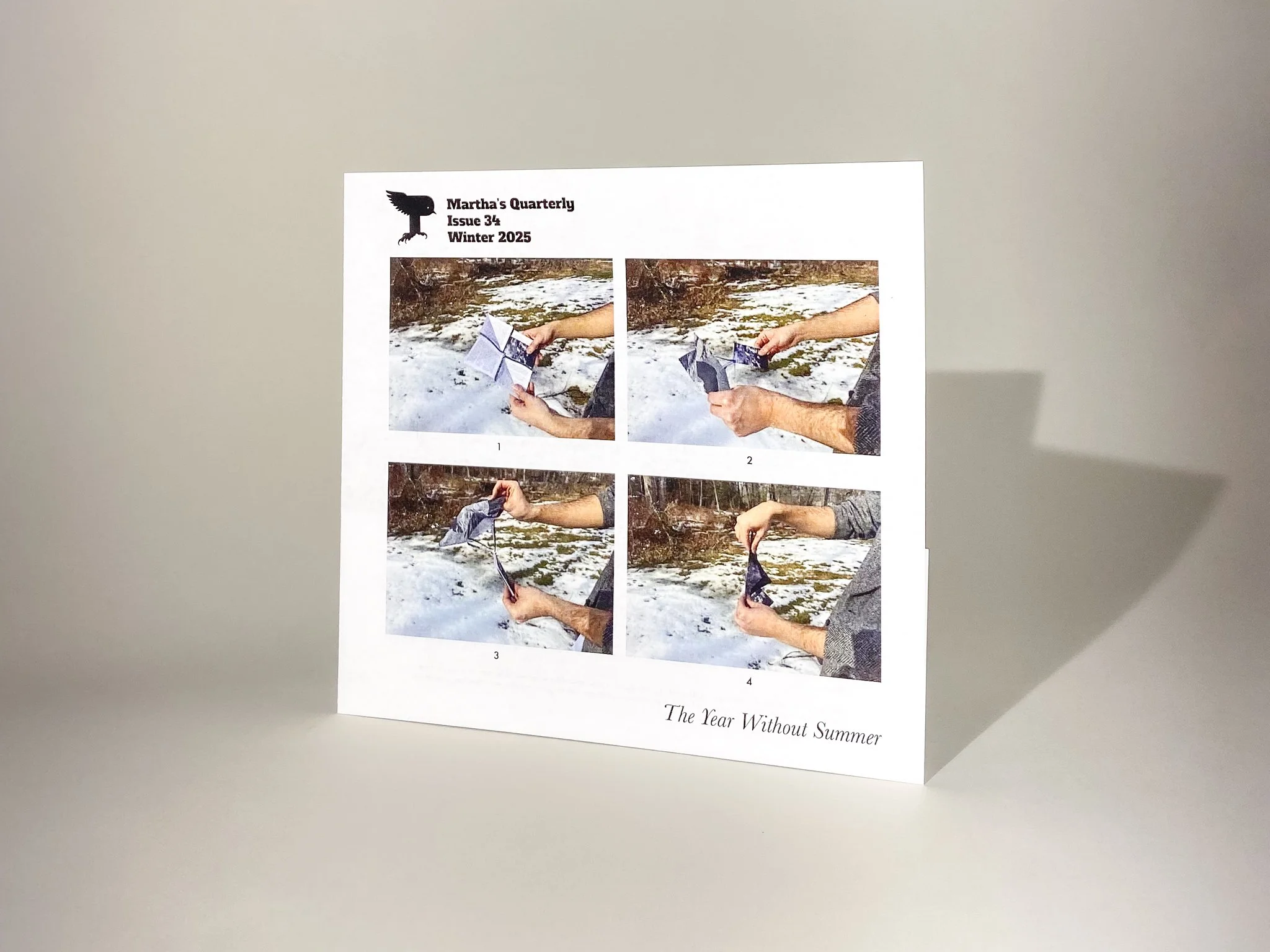MQ 2025
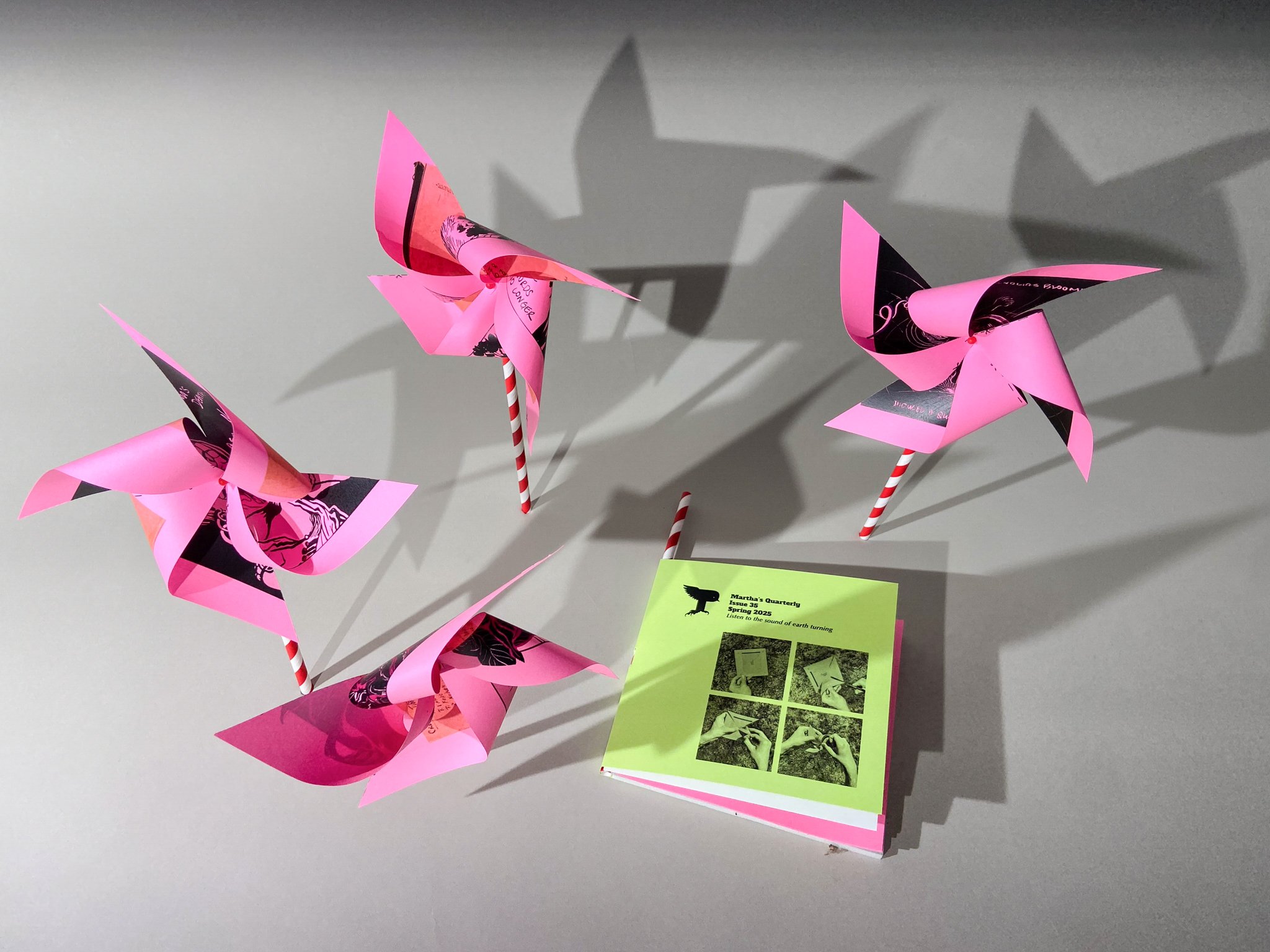
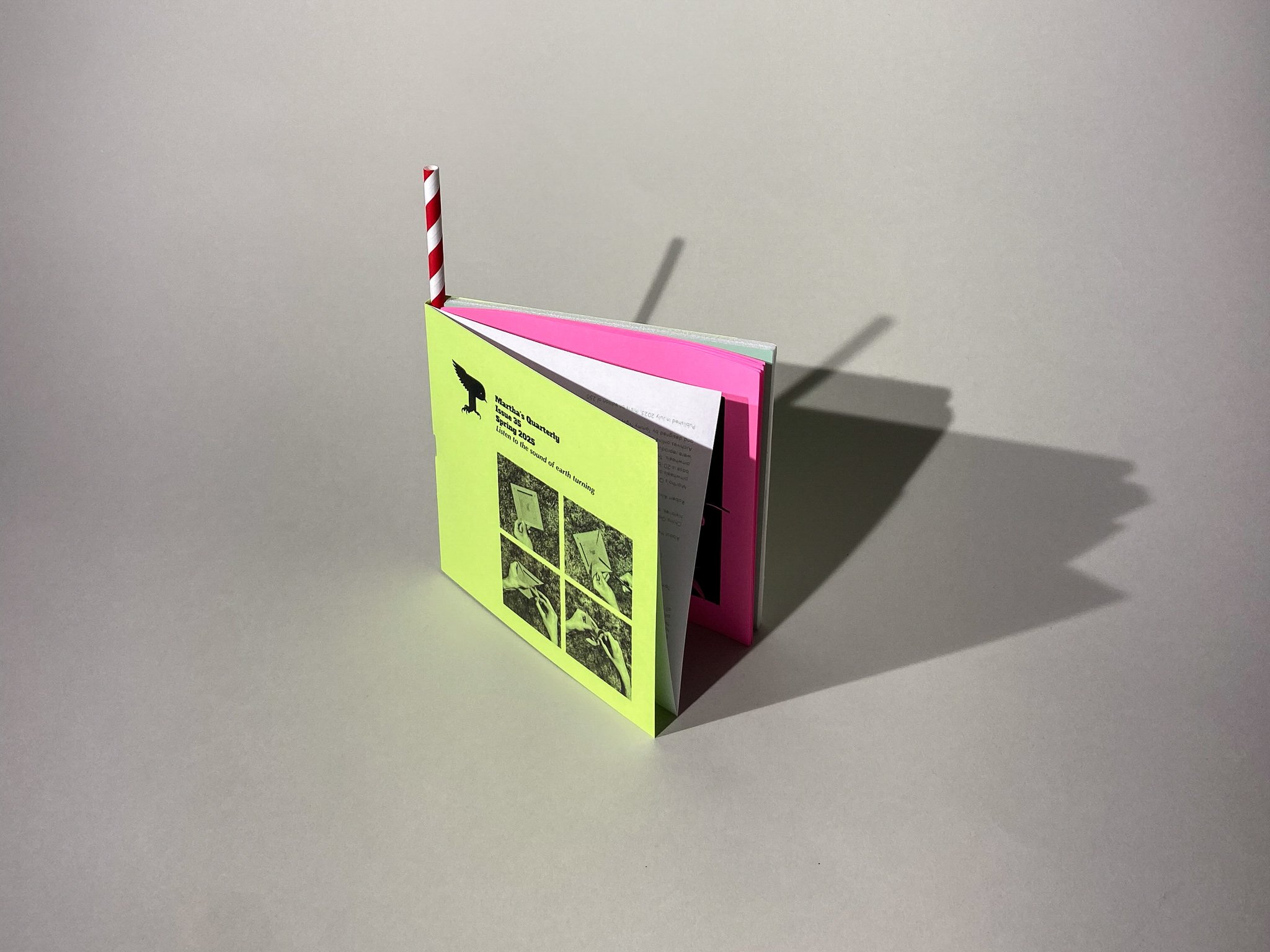
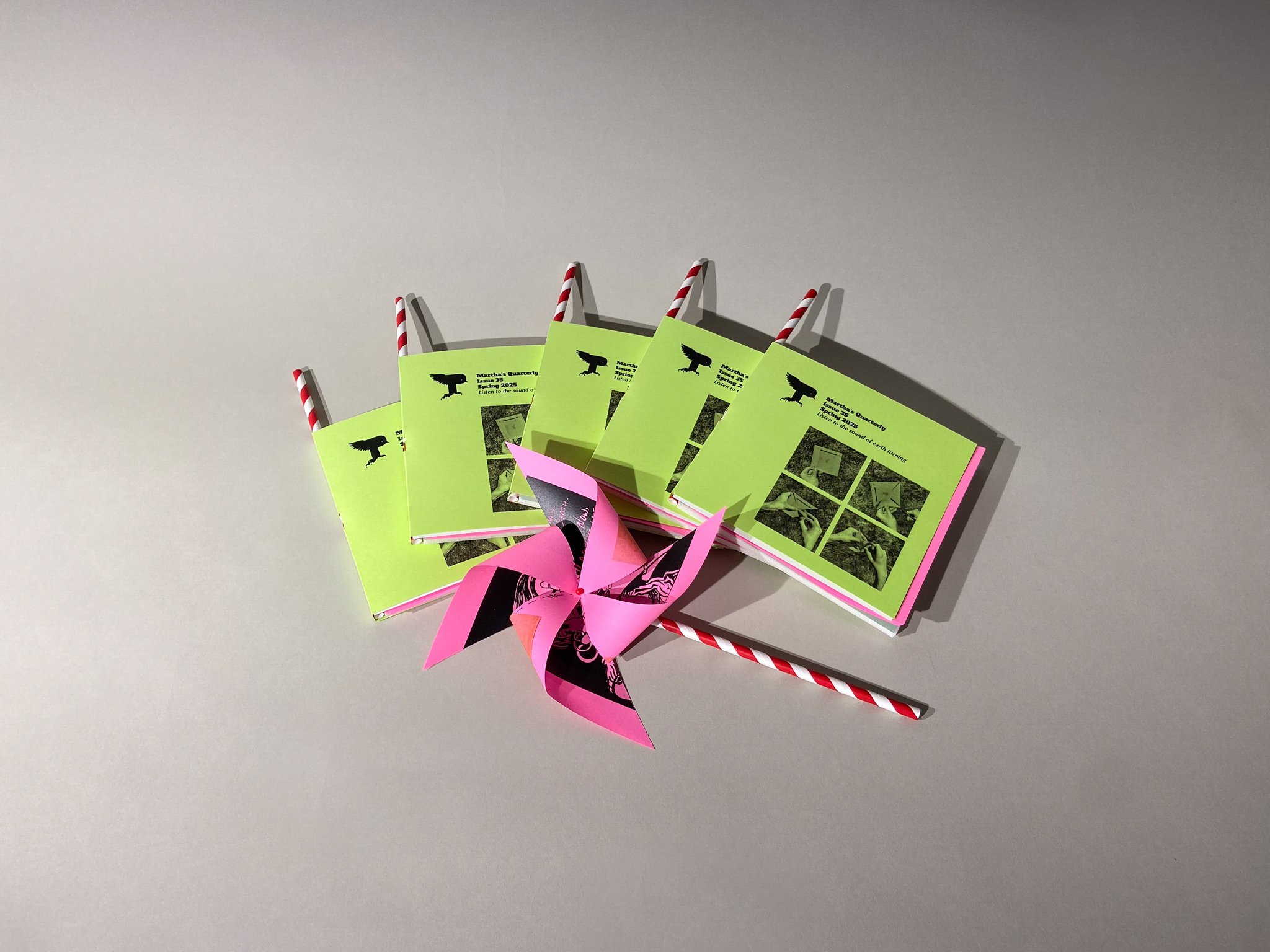
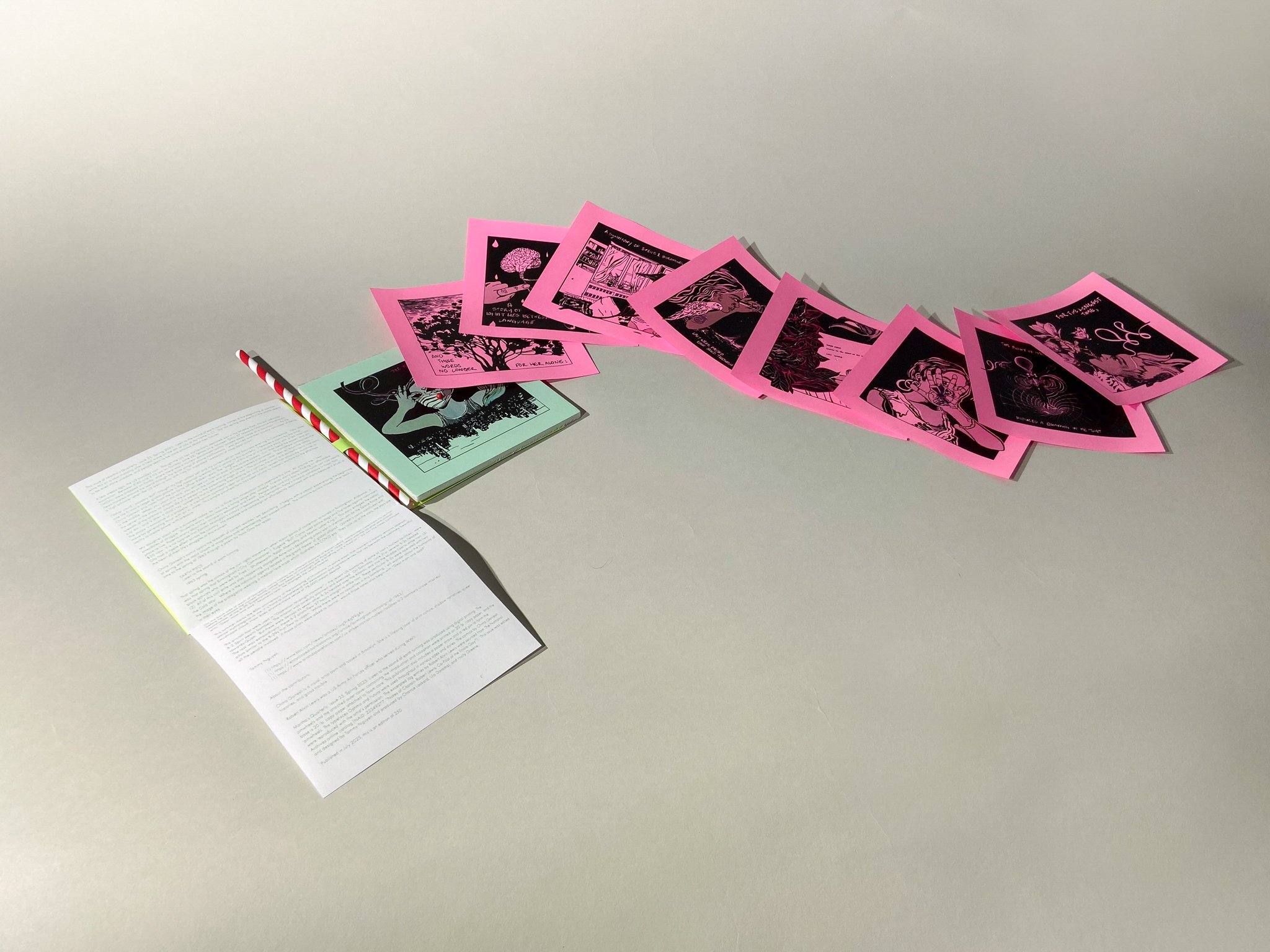
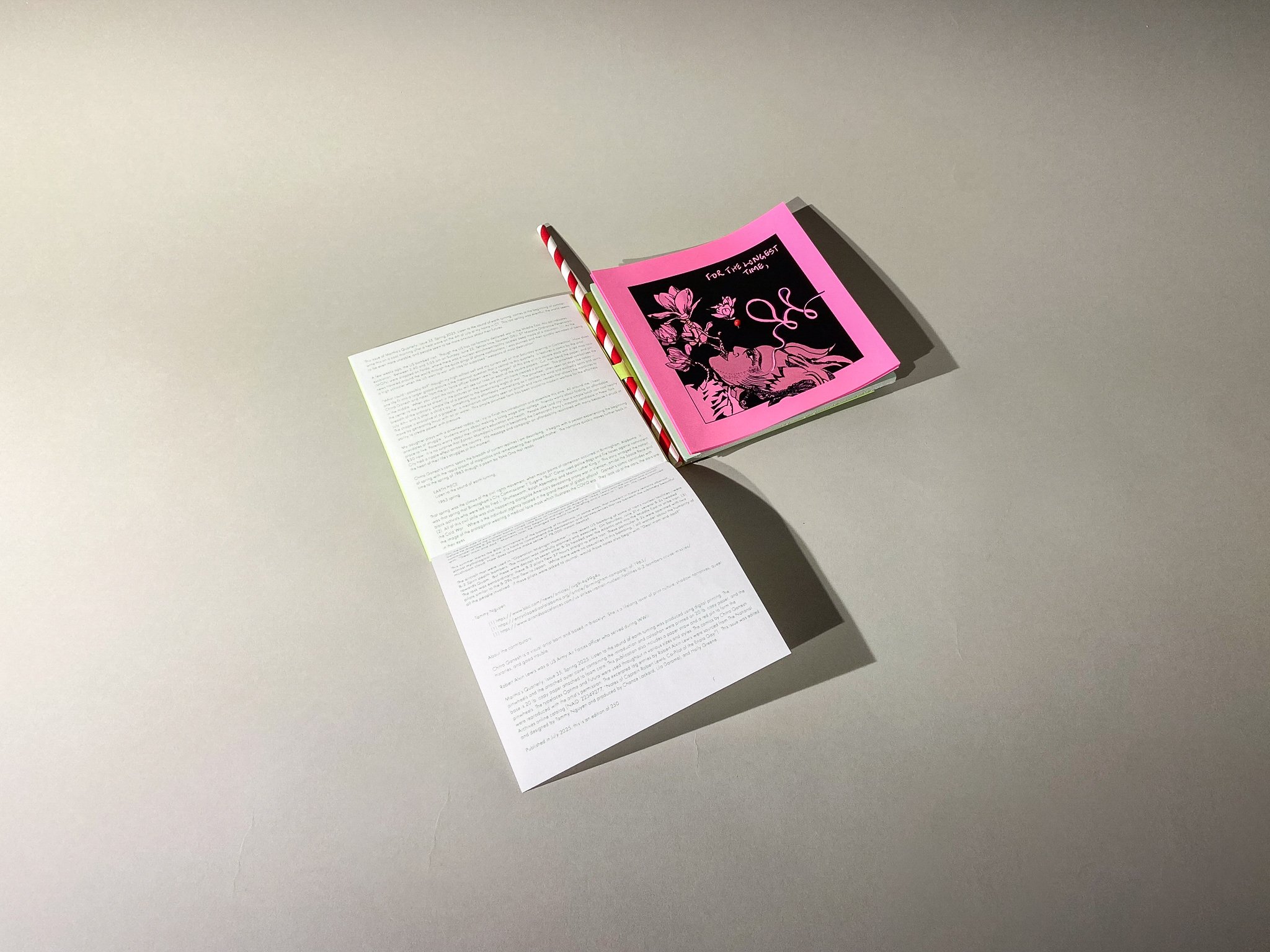
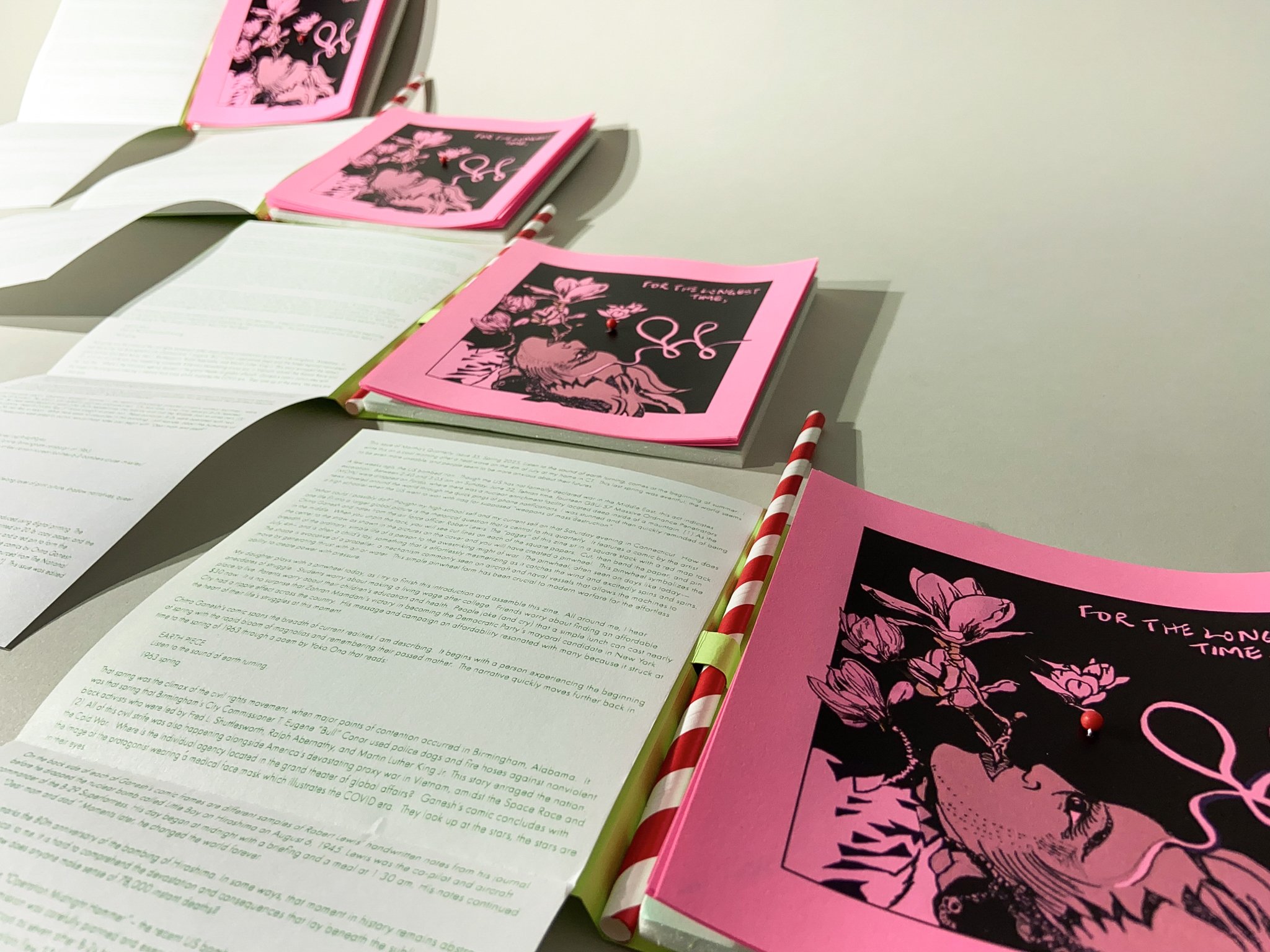
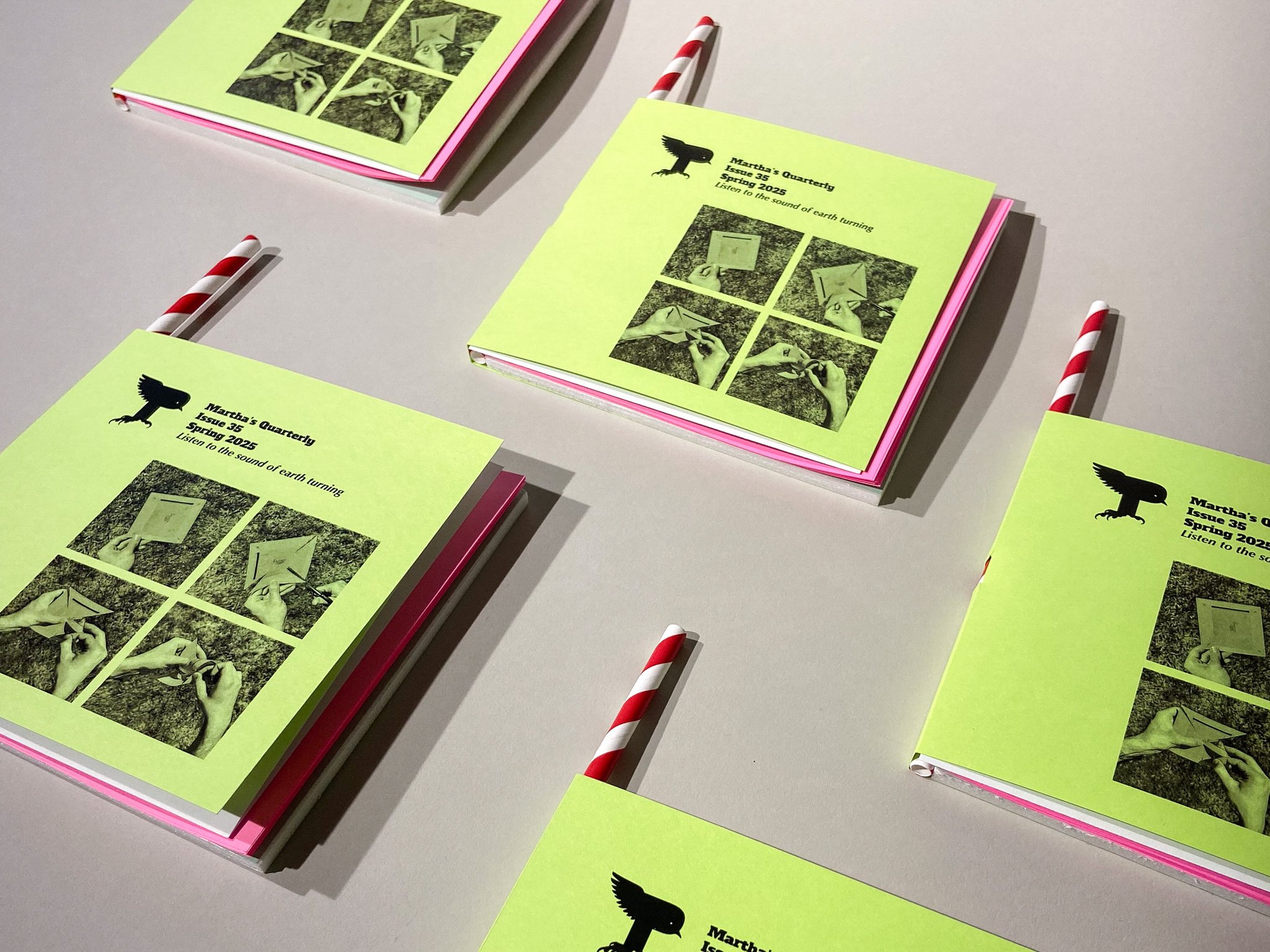
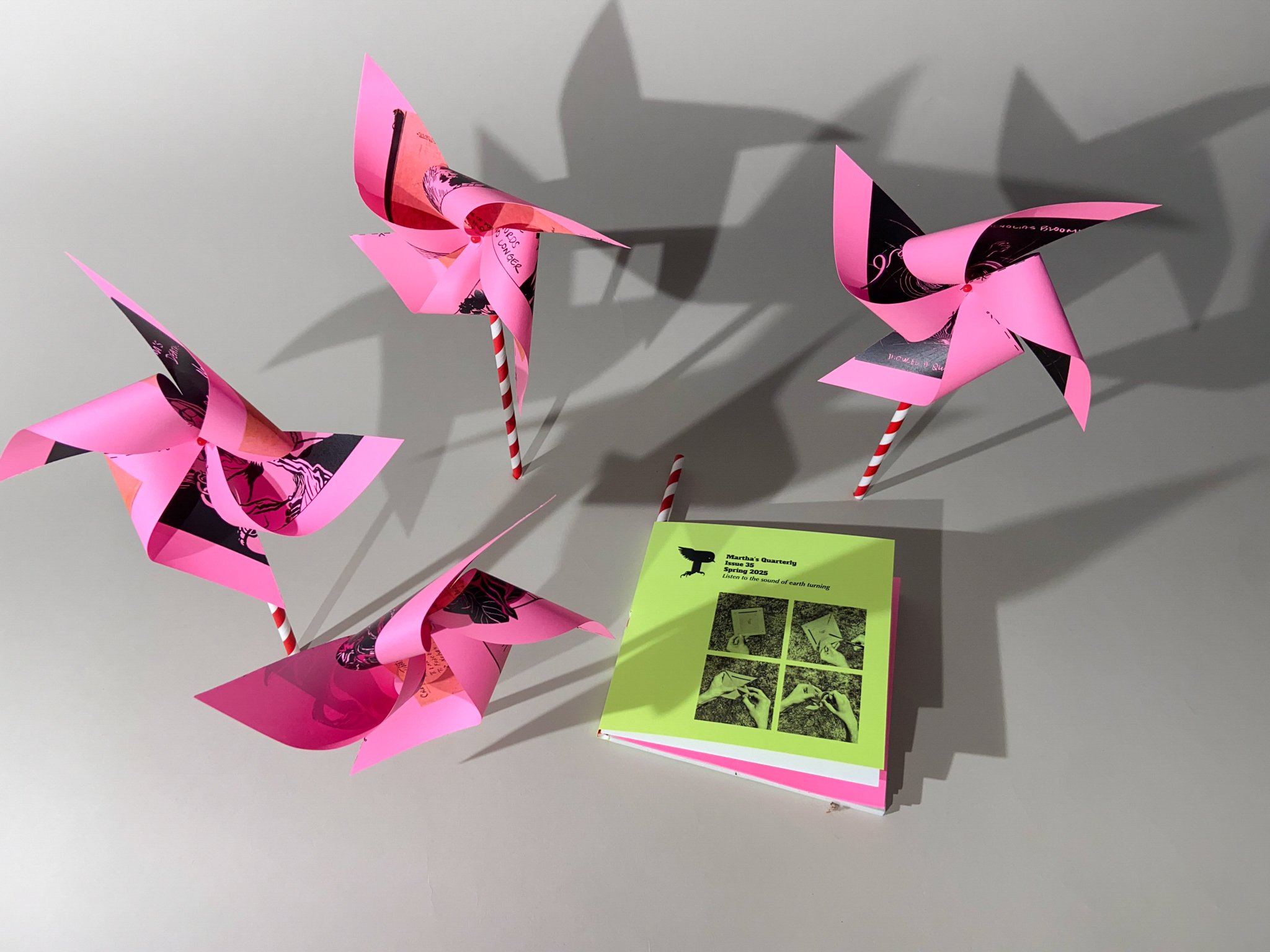
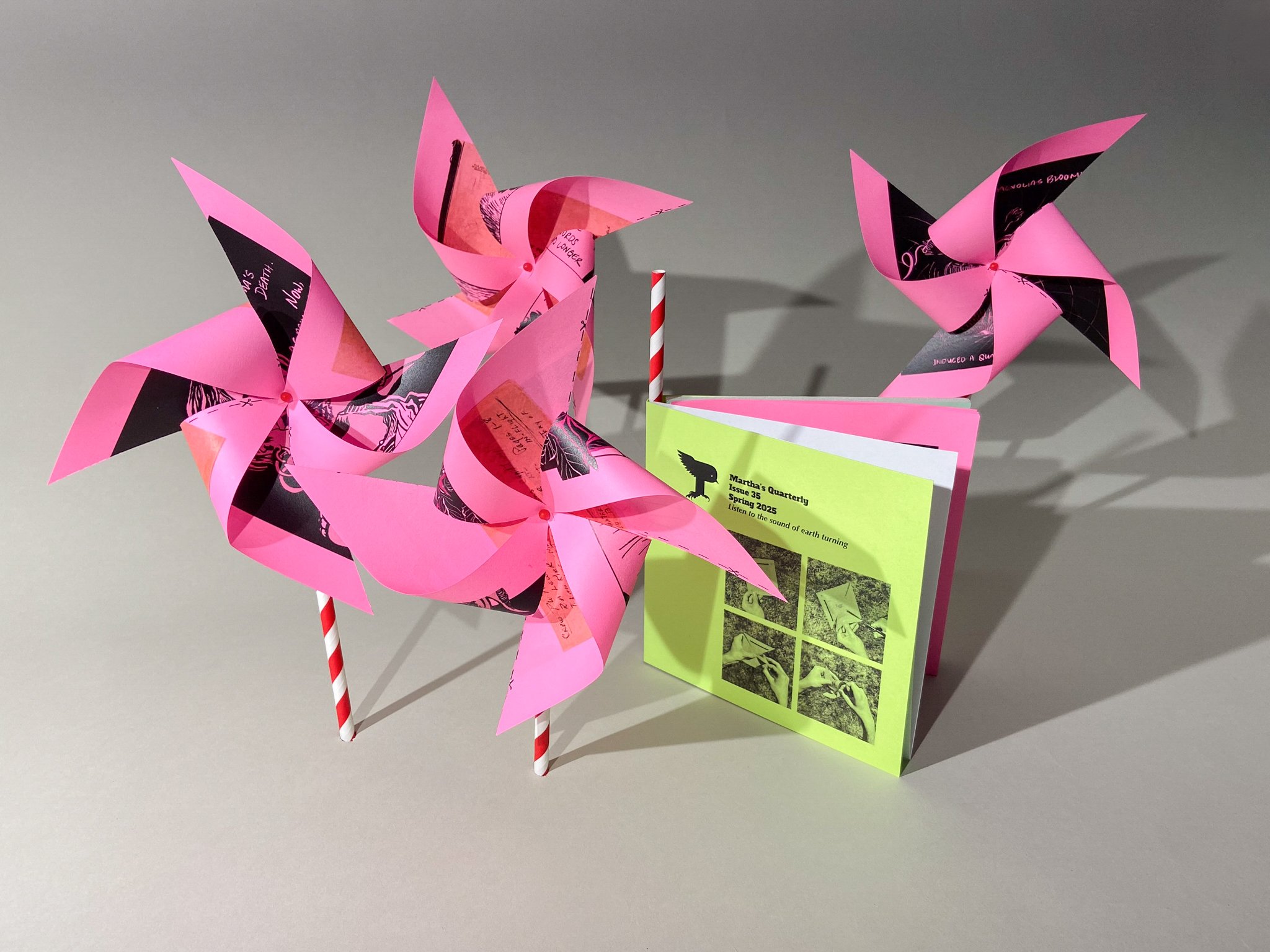

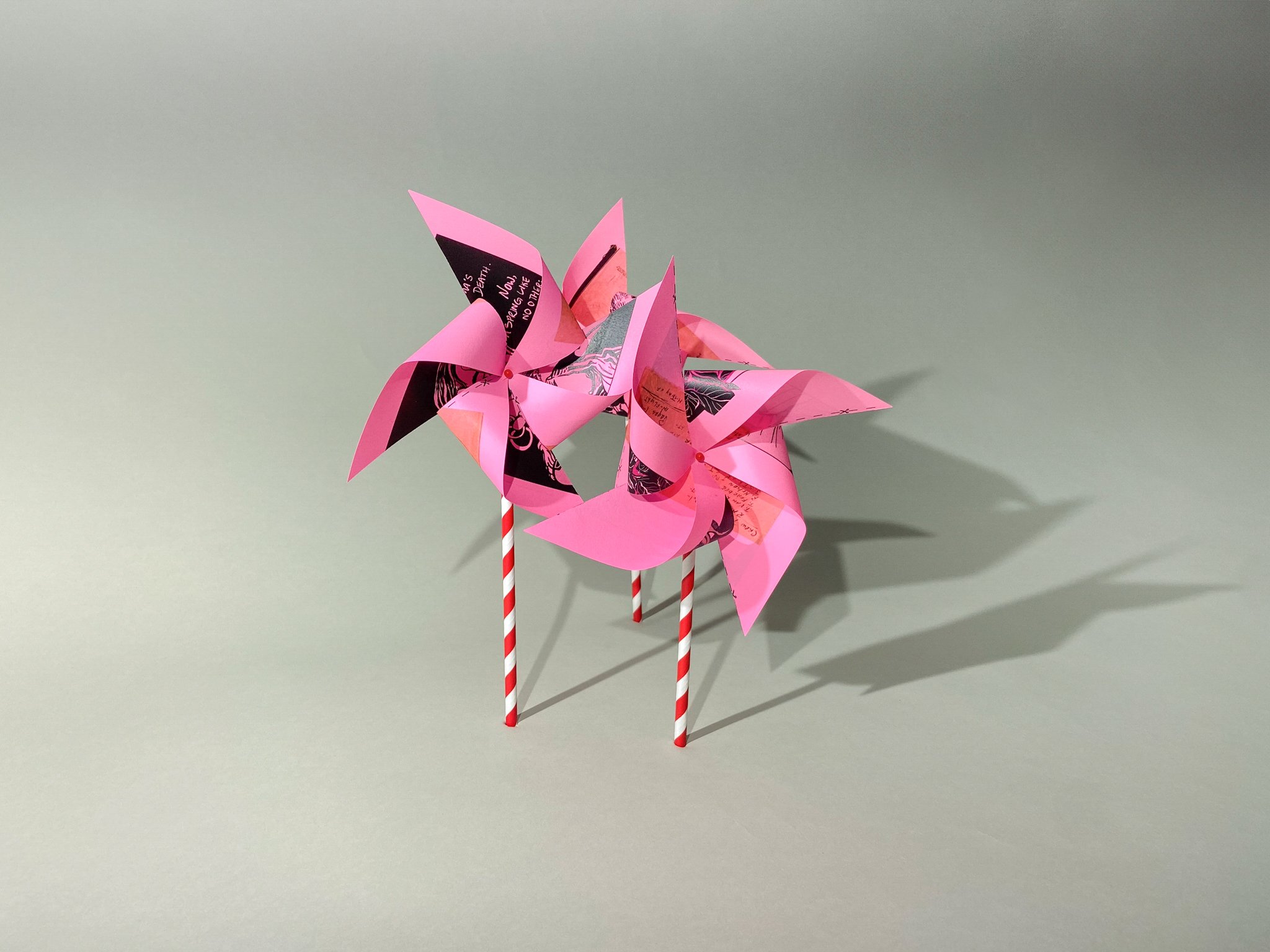
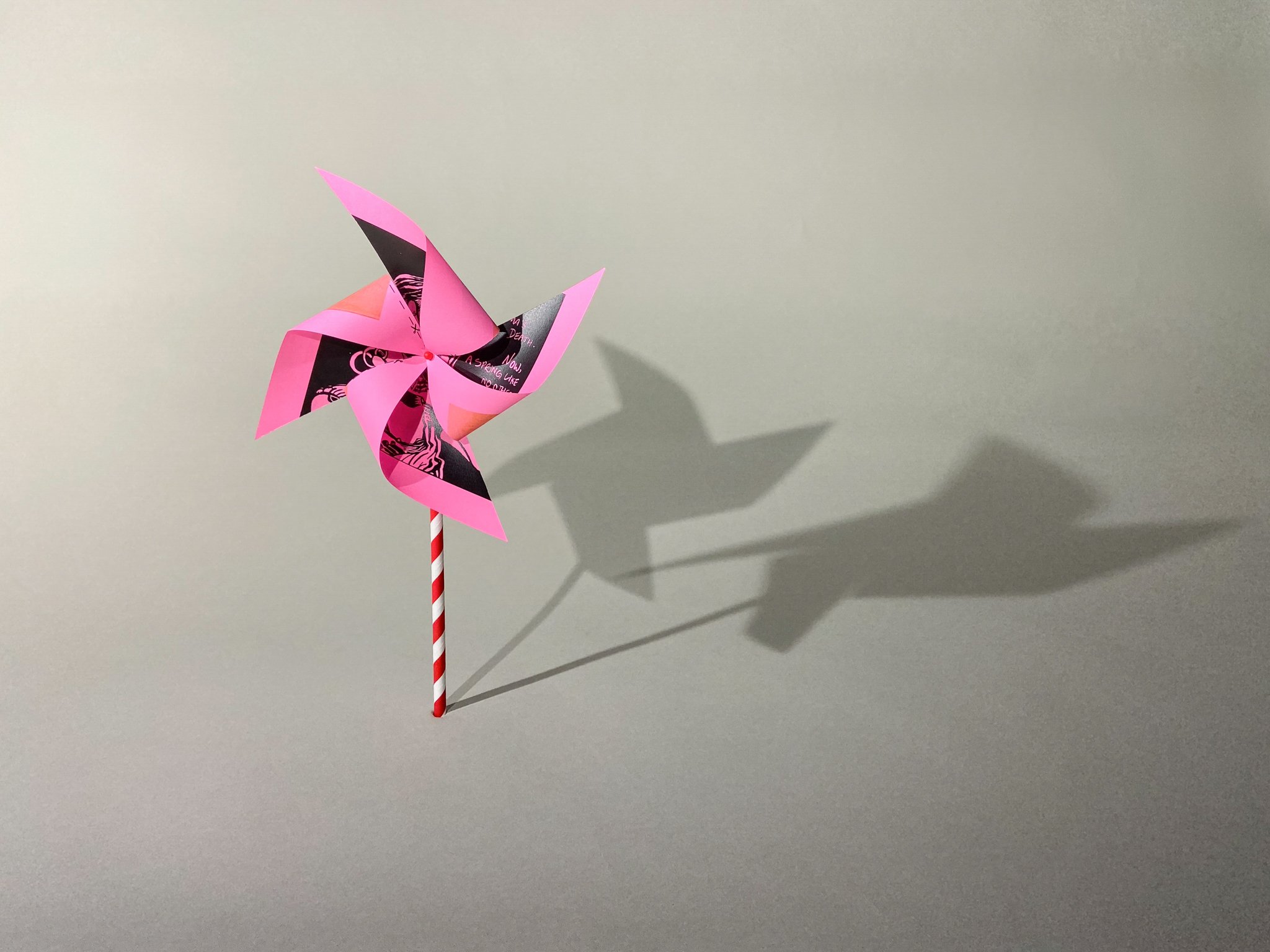
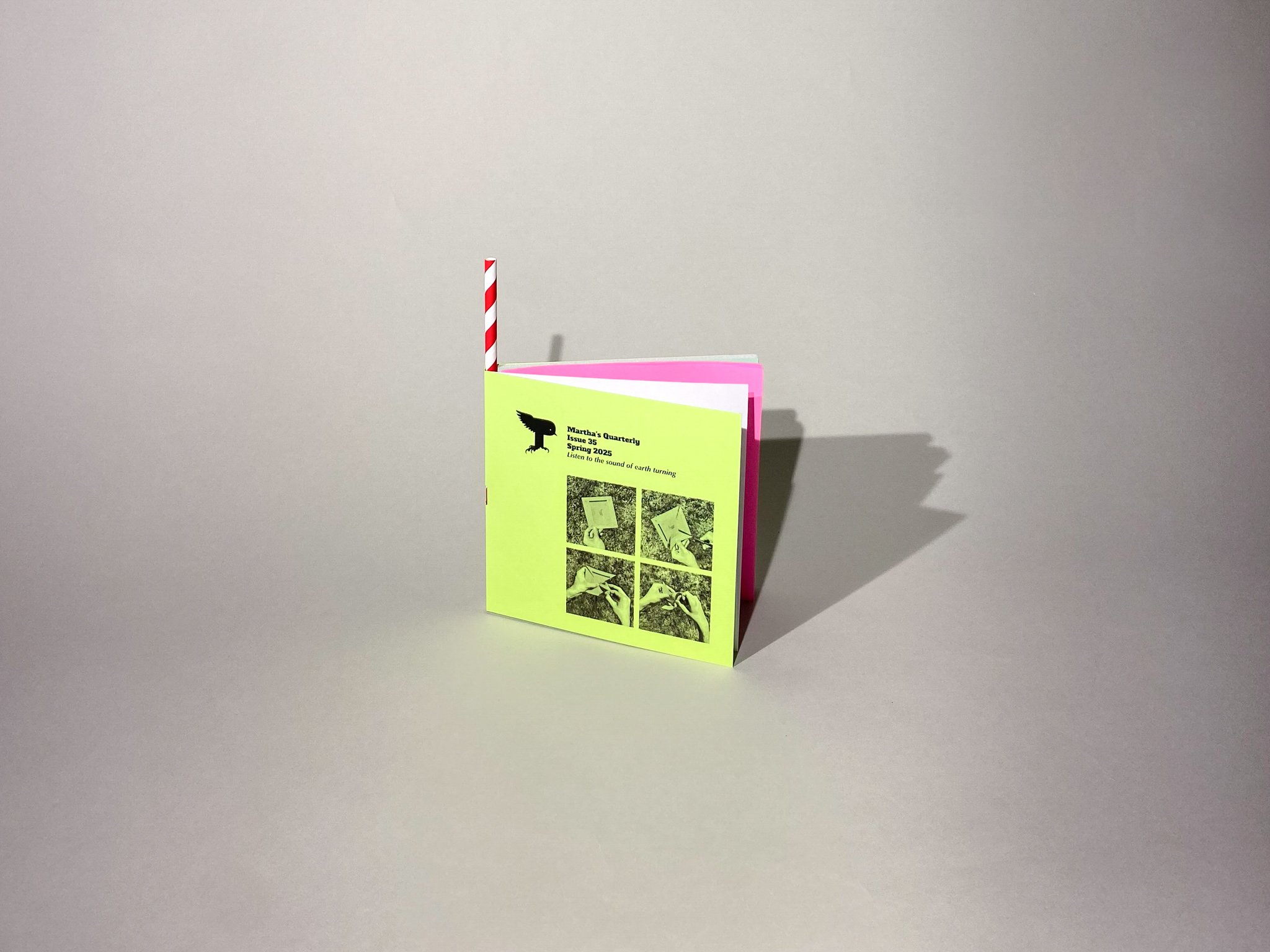
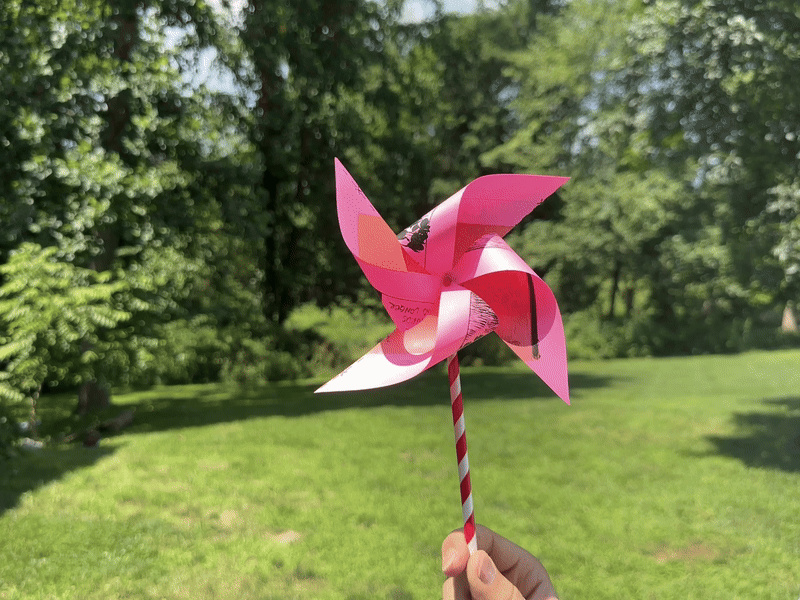
One subscription of four artist books a year starting with Spring 2025.
Martha's Quarterly
Issue 35
Spring 2025
Listen to the sound of earth turning
7.875” x 5.875”
About the contributors:
Chitra Ganesh is a visual artist born and based in Brooklyn. She is a lifelong lover of print culture, shadow narratives, queer histories, and good trouble.
Robert Alvin Lewis was a US Army Air Forces officer who served during WWII.
Two subscriptions of four artist books a year starting with Spring 2025. Great gift for a friend! Fill out any additional addresses at check-out.
This issue of Martha’s Quarterly, Issue 35, Spring 2025, Listen to the sound of earth turning, comes at the beginning of summer. I write this on a cool morning after a heat wave on the 4th of July at my home in CT. This last spring was eventful; the world seems to be even more unstable, and people seem to be more anxious about their futures.
A few weeks ago, the US bombed Iran. Though the US has not formally declared war in the Middle East, this act indicates escalation. Between 2:40 and 3:05 am on Sunday, June 22, Tehran time, fourteen GBU-57 Massive Ordnance Penetrators (MOPs) were dropped on Fordo, where there was a nuclear enrichment facility located deep inside of a mountain. (1) As the news traveled around the world through the quick pings of phone notifications, I was stunned and then quickly reminded of being a high schooler when the US went to war with Iraq for supposed “weapons of mass destruction”.
“What could I possibly do?” thought my high-school self and my current self on that Saturday evening in Connecticut. How does one life fit into a larger global picture is the rhetorical question that is central to this quarterly. It features a comic by the artist Chitra Ganesh and notes from the air force officer Robert Lewis. The “pages” of this zine sit in a square stack with a red map tack in the middle. When you unpin the tack, you will see cut lines on each of the square papers. Cut, then bend the paper, and pin the center to the straw as shown in the pictures on the cover and you will have created a pinwheel. This pinwheel symbolizes the breadth of the ordinary, simple life of a person to the awestriking might of war. The pinwheel, often seen on days like today-– July 4th– and is often a child’s toy, something that is effortlessly mesmerizing as it catches the wind and excitedly spins and spins. The shape is evocative of a propeller, a mechanism commonly seen on aircraft and naval vessels that allows the machines to move by generating thrust with air or water. This simple pinwheel form has been crucial to modern warfare for the effortless ability to create power with pressure.
My daughter plays with a pinwheel today, as I try to finish this introduction and assemble this zine. All around me, I hear anecdotes of struggle. Students worry about making a living wage after college. Friends worry about finding an affordable place to live. Parents worry about their children’s education and health. People joke (and cry) that a simple lunch can cost nearly $30 now. It is no surprise that Zohran Mamdani’s victory in becoming the Democratic Party’s mayoral candidate in New York City had a ripple effect across the country. His message and campaign on affordability resonated with many because it struck at the heart of their life’s struggles at this moment.
Chitra Ganesh’s comic spans the breadth of current realities I am describing. It begins with a person experiencing the beginning of spring with the rapid bloom of magnolias and remembering their passed mother. The narrative quickly moves further back in time to the spring of 1963 through a poem by Yoko Ono that reads:
EARTH PIECE
Listen to the sound of earth turning.
1963 spring
That spring was the climax of the civil rights movement, when major points of contention occurred in Birmingham, Alabama. It was that spring that Birmingham’s City Commissioner T. Eugene “Bull” Conor used police dogs and fire hoses against nonviolent black activists who were led by Fred L. Shuttlesworth, Ralph Abernathy, and Martin Luther King Jr. This story enraged the nation. (2) All of this civil strife was also happening alongside America's devastating proxy war in Vietnam, amidst the Space Race and the Cold War. Where is the individual agency located in the grand theater of global affairs? Ganesh’s comic concludes with the image of the protagonist wearing a medical face mask which illustrates the COVID era. They look up at the stars, the stars are in their eyes.
On the back side of each of Ganesh’s comic frames are different samples of Robert Lewis’ handwritten notes from his journal before he dropped the nuclear bomb called Little Boy on Hiroshima on August 6, 1945. Lewis was the co-pilot and aircraft commander of the B-29 Superfortress. His day began at midnight with a briefing and a meal at 1:30 am. His notes continued with, “Dear mom and dad.” Moments later, he changed the world forever.
This summer marks the 80th anniversary of the bombing of Hiroshima. In some ways, that moment in history remains abstract, almost mythological to me. It is hard to comprehend the devastation and consequences that lay beneath the sublimely beautiful mushroom cloud. How does anyone make sense of 78,000 instant deaths?
The aircraft that were used in “Operation Midnight Hammer”– the recent US bombing of some of Iran’s nuclear facilities– were B-2 Spirit stealth bombers. The mission was carefully planned and executed. On Saturday, June 21st, several B-2s headed towards Guam. But these were decoys as seven other B-2s headed over the Atlantic and into the Middle East to strike Iran. (3) The task was extraordinary; these B-2 pilots flew 37 hours straight to strike Iran. These particular B-2s were operated with two pilots similar to the B-29s that flew to Japan. While there were no casualties in this bombing, I still wonder about the humanity of all the people involved. If those pilots were asked to journal, would those notes also begin with “Dear mom and dad?”
- Tammy Nguyen
https://www.bbc.com/news/articles/cvg9r4q99g4o
https://encyclopediaofalabama.org/article/birmingham-campaign-of-1963/
https://www.airandspaceforces.com/us-strikes-iranian-nuclear-facilities-b-2-bombers-cruise-missiles/
@passengerpigeonpress
Martha’s Quarterly, Issue 35, Spring 2025, Listen to the sound of earth turning was produced using digital printing. The pinwheels and the attached outer cover containing the introduction and colophon were printed on 20 lb. copy paper, and the base is 20 lb. copy paper attached to foam core. This publication also includes a paper straw and a red pin to form the pinwheels. The typefaces Optima and Futura were used throughout in various sizes and styles. The comics by Chitra Ganesh were reproduced with the artist’s permission. The excerpted log entries by Robert Alvin Lewis were sourced from The National Archives online catalog [NAID: 22349277, “Notes of Captain Robert Lewis, Co-Pilot of the Enola Gay”]. This issue was edited and designed by Tammy Nguyen and produced by Chance Lockard, Lila Doromal, and Holly Greene.
Published in July 2025, this is an edition of 250.


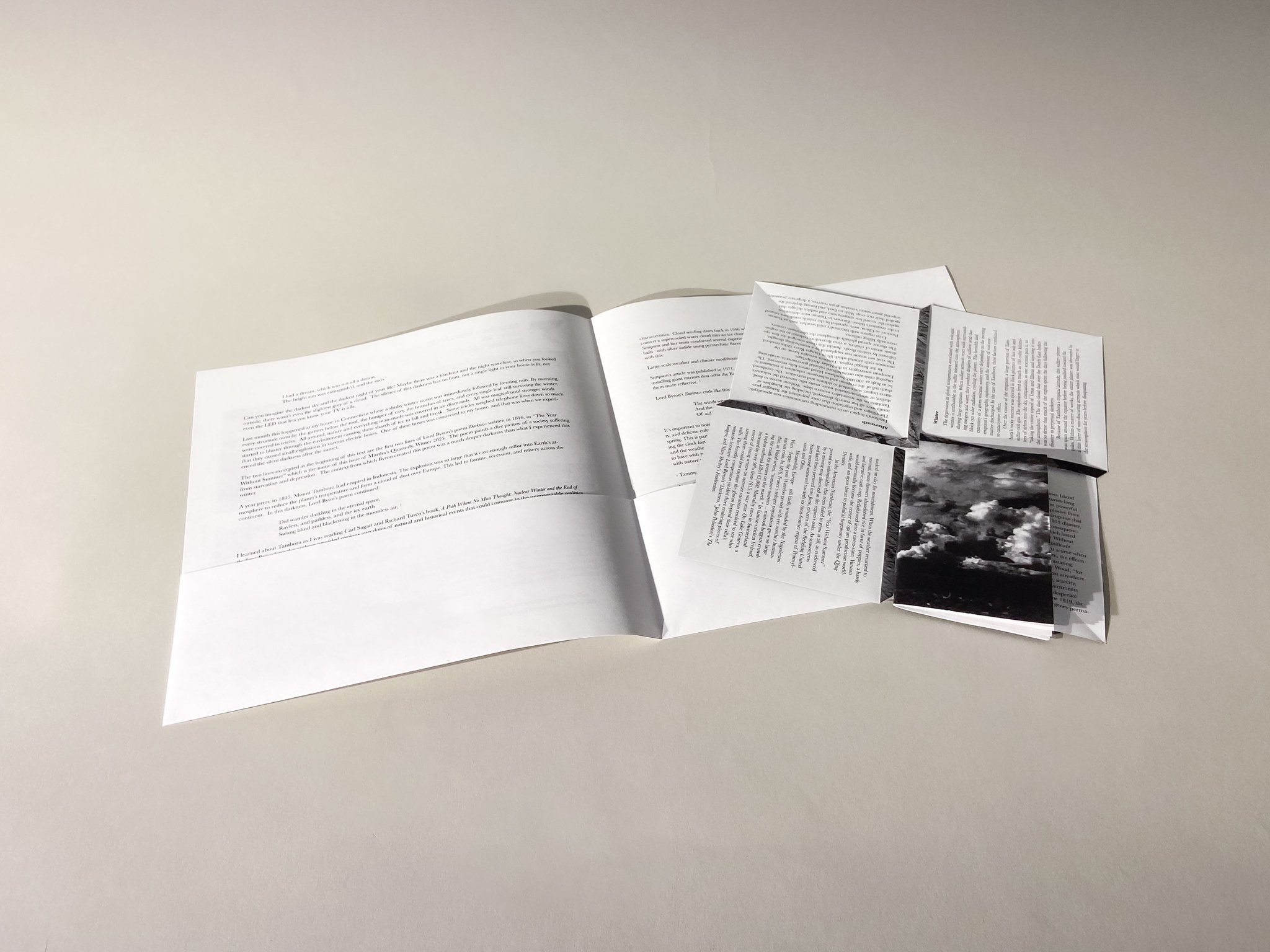


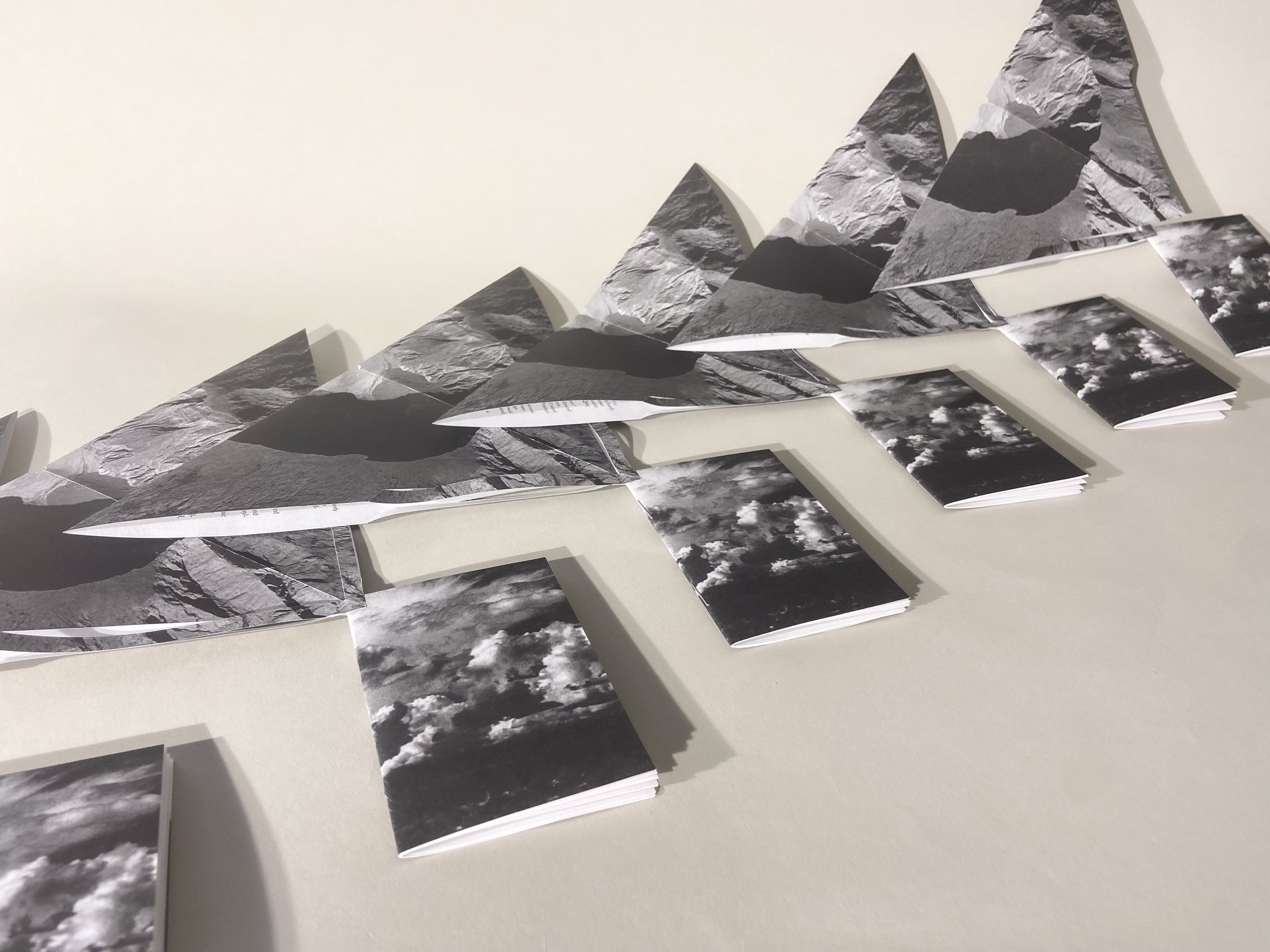


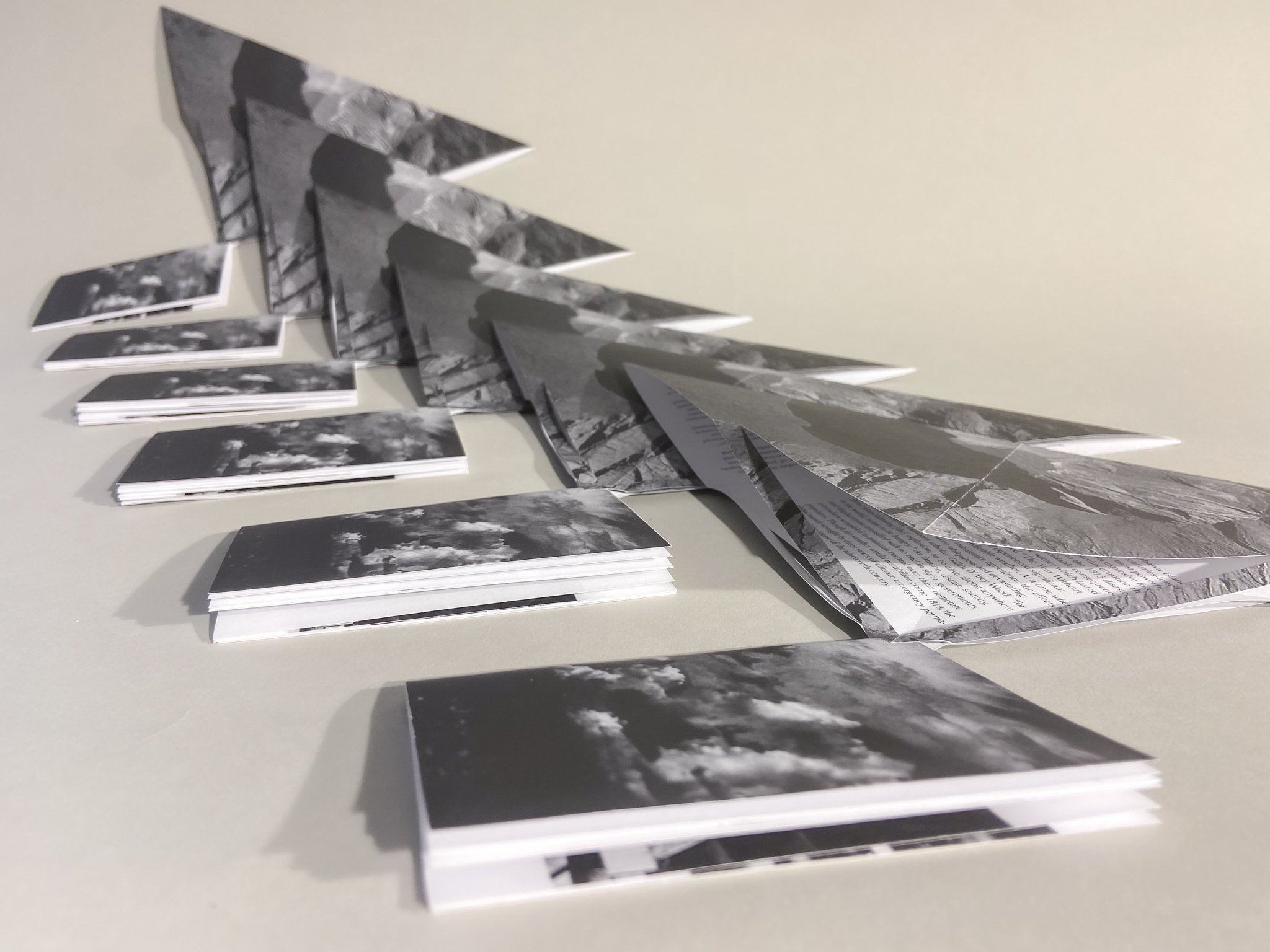


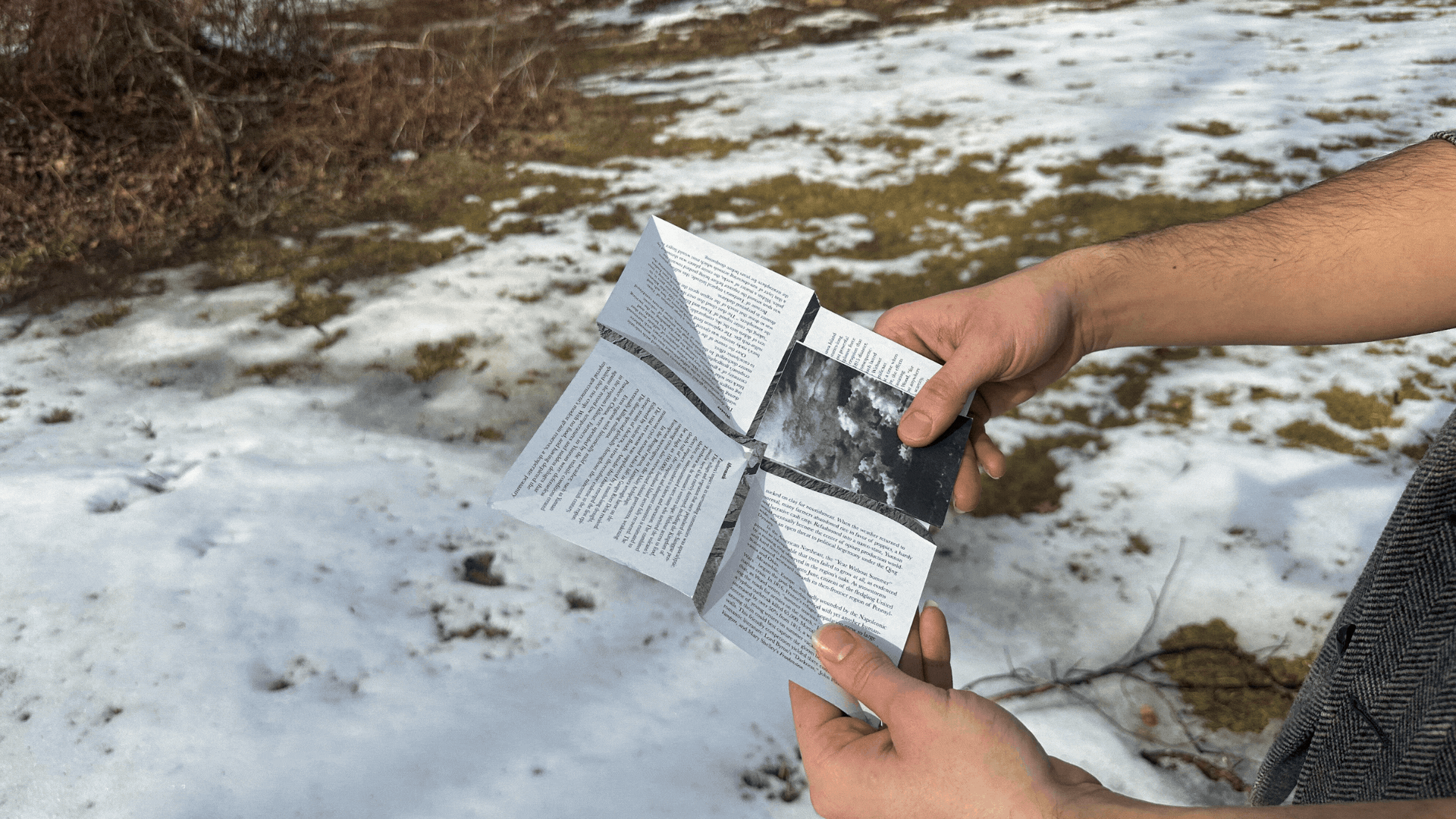
Martha's Quarterly
Issue 34
Winter 2025The Year Without Summer
~8.125” x 8.5”
About the contributors:
Joanne Simpson was the first woman in the United States to receive a Ph.D. in meteorology, which she received in 1949 from the University of Chicago. Simpson developed the first cloud model, discovered what makes hurricanes run, and revealed what drives the atmospheric currents in the tropics.
Chance Lockard is an artist, researcher, and volcano enthusiast based in New Haven, CT. He graduated from Wesleyan University in 2024 and has been an assistant at Tammy Nguyen Studio ever since.
I had a dream, which was not all a dream.
The bright sun was extinguish'd, and the stars (1)
Can you imagine the darkest sky and the darkest night of your life? Maybe there was a blackout and the night was clear, so when you looked outside, there wasn’t even the slightest grey of a cloud. The silence of this darkness has no hum, not a single light in your house is lit, not even the LED that lets you know your TV is idle.
Last month this happened at my house in Connecticut where a slushy winter storm was immediately followed by freezing rain. By morning, every structure outside: the gutters below the roof, the bumper of cars, the branches of trees, and every single leaf still surviving the winter, were covered in icicles. All around, nature and everything man-made was covered in ice diamonds. All was magical until stronger winds started to bluster through the environment causing these shards of ice to fall and break. Some icicles weighed telephone lines down so much that they caused small explosions in various electric boxes. One of these boxes was connected to my house, and that was when we experienced the silent darkness after the sunset.
The two lines excerpted at the beginning of this text are the first two lines of Lord Byron’s poem Darkness written in 1816, or “The Year Without Summer” which is the name of this issue of Martha’s Quarterly, Winter 2025. The poem paints a dire picture of a society suffering from starvation and depression. The context from which Byron created this poem was a much deeper darkness than what I experienced this winter.
A year prior, in 1815, Mount Tambora had erupted in Indonesia. The explosion was so large that it cast enough sulfur into Earth’s atmosphere to reduce the planet’s temperature and form a cloud of dust over Europe. This led to famine, recession, and misery across the continent. In this darkness, Lord Byon’s poem continued:
Did wander darkling in the eternal space,
Rayless, and pathless, and the icy earth
Swung blind and blackening in the moonless air; (2)
I learned about Tambora as I was reading Carl Sagan and Richard Turco’s book, A Path Where No Man Thought: Nuclear Winter and the End of the Arms where the authors provided copious anecdotes of natural and historical events that could compare to the unimaginable realities of a nuclear winter. I couldn’t believe that an eruption in Southeast Asia could have dismal effects on Europe a year later, and it made the fantasy of a nuclear winter much more tangible and frightening.
Morn came and went—and came, and brought no day,
And men forgot their passions in the dread (3)
Byron’s mention of “passions” is a subject I want to probe with this quarterly. Martha's Quarterly, Issue 34, Winter 2025, The Year Without Summer, opens like a parachute. The crater of Mount Tambora expands and then collects air while a small pamphlet covered in clouds anchors the whole zine down slowly, like someone escaping an aircraft. Inside are two pieces of writing. Underneath Mount Tambora’s crater is a summary by Chance Lockard of the catastrophic 1815 eruption. The small cloud pamphlet includes an article by meteorologist Joanne Simpson on cloud seeding. The combination of these two phenomena, volcanic eruptions by nature and cloud seeding by man, aims to blur notions about the sublime by juxtaposing the profundity of events created by nature and by man. When Byron’s poem mentioned forgotten passions, I thought about how recent catastrophes and global innovations have been a result of man’s unforgettable passions interwoven with nature’s forces.
I have long been interested in geoengineers. The first Martha’s Quarterly that explored the subject was in the summer of 2017 in Giant Balloons. Eight years later, I’m still awestruck by such grand human interventions with the planet’s weather and atmospheric patterns and characteristics. Cloud seeding dates back to 1946 when Vincent Schafer of General Electric discovered that small pellets of dried ice could convert a supercooled water cloud into an ice cloud. This idea developed into several projects over the next decades, and in the 60s, Joanne Simpson and her team conducted several experiments that involved seeding cumulus clouds – puffy low-lying clouds that look like cotton balls– with silver iodide using pyrotechnic flares. Some of these experiments resulted in significant rainfall. Simpson concluded her article with this:
Large-scale weather and climate modification– once a science fiction dream– may now be on our horizon. (4)
Simpson’s article was published in 1971, and today, in 2025, there are many proposals to intervene with the earth’s climate. These include installing giant mirrors that orbit the Earth, spraying sulfate aerosols into the stratosphere and modifying clouds, plants, and ice to make them more reflective. (5)
Lord Byron’s Darkness ends like this:
The winds were wither'd in the stagnant air,
And the clouds perish'd; Darkness had no need
Of aid from them—She was the Universe. (6)
It’s important to note that I am presenting the subjects of Mount Tambora and cloud seeding in a chaotic time of war, economic uncertainty, and delicate cultural tensions. I’m finishing this introduction the day before daylight savings time when the days become longer in the spring. This is partly because of the Earth’s tilt as it orbits the sun, but also because since World War I, the United States has practiced shifting the clock forward to extend the day, save fuel, and maximize the work day. Somewhere in between this 19th-century volcanic eruption and the weather-altering technology of the 20th-century is a place where man and nature must meet. The kind of relationship man wants to have with nature and vice versa seems to lie at the heart of many existential troubles today, and I hope that our civilizations’ negotiations with nature will continue with the arrival of all seasons so that with all that dies in one generation, the next can thrive.
– Tammy Nguyen
Note: To open and use the parachute zine, follow the steps demonstrated in the images on the front and back of this cover.
Bryon, George Gordon. “Darkness.” Poetry Foundation, Poetry Foundation, https://www.poetryfoundation.org/poems/43825/darkness-56d222aeeee1b.
Bryon, George Gordon. “Darkness.” Poetry Foundation, Poetry Foundation, https://www.poetryfoundation.org/poems/43825/darkness-56d222aeeee1b.
Bryon, George Gordon. “Darkness.” Poetry Foundation, Poetry Foundation, https://www.poetryfoundation.org/poems/43825/darkness-56d222aeeee1b.
Simpson, Joanne. “Increasing Rainfall by Cloud Seeding.” The Science Teacher, vol. 38, no. 9, 1971, pp. 17–21. JSTOR, http://www.jstor.org/stable/24120178.
“Geoengineering: the basics.” Geoengineering Monitor, https://www.geoengineeringmonitor.org/what-is-geoengineering.
Bryon, George Gordon. “Darkness.” Poetry Foundation, Poetry Foundation, https://www.poetryfoundation.org/poems/43825/darkness-56d222aeeee1b.
Chance Lockard’s citations:
Wood, Gillen D’Arcy, Tambora: The Eruption That Changed the World, Princeton University Press, 2014.
Wood, Gillen D’Arcy, “Tambora: The Eruption That Changed the World,” Lecture presented at the Brigham Young University David M. Kennedy Center for International Studies, Provo, UT, September 2015.
https://en.wikipedia.org/wiki/1815_eruption_of_Mount_Tambora
@passengerpigeonpress
Martha’s Quarterly, Issue 34, Winter 2025, The Year Without Summer was produced using digital printing for all of its printed components. The inner parachute, pamphlet, and outside cover were printed on 20 lb. paper. The fonts used throughout were Futura and Baskerville in different sizes and styles. “Increasing Rainfall by Cloud Seeding” by Joanne Simpson was reproduced with permission from The Science Teacher, December 1971, Vol. 38, No. 9, pp. 17-21. Copyright 1971 National Science Teaching Association. Tambora incident summary written by Chance Lockard. This issue was edited and designed by Tammy Nguyen and produced by Chance Lockard with assistance from Daniella Porras and Holly Greene.
Published in March 2025, this is an edition of 250.
